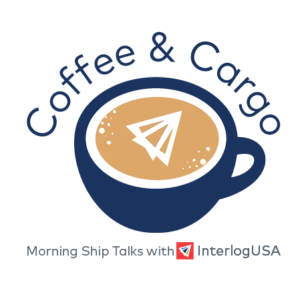Competitive Edge
February 16th, 2022
Stay Current with Interlog’s Weekly Newsletter:
Sign up for our next Coffee & Cargo webinar –> CLICK HERE
To watch today’s webinar –-> CLICK HERE
Ocean Freight Market Update
Headlines
- The Port of New York/New Jersey had a record 2021, finishing 14,000 twenty-foot equivalent units shy of 9 million. The volume was 18% above that in 2020, which was a record year itself.
- Swedish tanker operator Terntank made history when its new vessel arrived at Gothernburg port as the first tanker to perform zero-emissions operations.
- Delta Air Lines said late Friday it has extended restrictions and stopped accepting all products at Detroit Metropolitan Airport destined for Montreal and Toronto because of limited access to roadways and bridges into the cities resulting from trucker-led protests over the Canadian government’s pandemic mandates.
UPDATE: Notable U.S./Canada Port Congestion
- Houston: 58 Backlogged Vessels
- Charleston: 39 Backlogged Vessels
- Norfolk/Newport News: 35 Backlogged Vessels
- Los Angeles/Long Beach: 50 Backlogged Vessels
- Note: This does not include LA/LB bound vessels waiting at ports of origin
- Vancouver: 67 Backlogged Vessels
IMPORT: Asia to North America (TPEB)
Recent Developments:
- Congestion and trucking capacity shortages remain critical with no expectation to ease
- Carriers prefer USEC bookings due to continuing congestion in LA/LB
- Carriers expect strong post-Chinese New Year demand even though many shippers are facing COVID-related uncertainties with production
Rates: Rate levels remain elevated. Shippers with urgent cargo or those looking to restore empty inventories are paying premium rates to secure space.
Space: Space remains critical.
Capacity/Equipment: Capacity remains severely under. Equipment deficits critical.
TIPS: Book at least 4 weeks prior to CRD. Strongly consider premium service and carrier IPIs through the PSW gateway. Be flexible as it comes to equipment and routing.
IMPORT: Europe to North America (TAWB)
Recent Developments:
- Schedule reliability in 2021 was 50 percent below the average performance over the past eight years
- USEC port congestion is worsening as carriers currently report long vessel wait times in Charleston and Miami ports
- New York port currently has manageable congestion
- USWC ports, notably Long Beach/Los Angeles, remain heavily congested
- Yard congestion at LB/LA has slightly improved
Rates: Rates levels to remain notably high. Further increases are expected through February.
Space: Space remains critical, especially for the USWC.
Capacity/Equipment: Capacity remains tight for both North Europe and Mediterranean services. Equipment availability at ports, however shortages remain at inland terminals.
TIPS: Book 6 or more weeks prior to CRD. Strongly consider premium service for higher reliability and no-roll guarantees.
EXPORT: North America to Asia
Recent Developments:
- Diminishing schedule integrity is contributing to void sailings, delays, vessel cut-offs at ports, and challenging post earliest return dates
- Vessel arrivals remain fluid for USWC POLs
- For the USEC, Savannah operations have seen improvements, but New York has seen increasing delays
- Rail availability for USWC has become limited with carriers firmly adhering to allocations
Rates: GRI advisories are out for transshipment ports and Oceania destinations for early February.
Capacity: Available capacity remains fluid for USWC POLs. USEC capacity has become for readily available.
Equipment: IPI origins remain adversely affected by deficits on containers and chassis. Standard equipment availability has not been an issue, but special equipment is remains elusive.
TIPS: Book 4 to 6 weeks prior to CRD to secure equipment and vessel space.
AIR FRIEGHT: United States
- Demand to Asia is steadily increasing after Chinese New Year. Europe and Latin America will remain stable with its demand.
- Airlines are back on schedule along with manageable capacity
- Larger shipments from major outbound gateways can take 2 to 3 days from booking to uplift.
- LAX/ORD/JFK terminals have reduced the backlog of inbound cargo rendering a positive effect on the export side.
- Rates to Latin America, Europe, and Asia have not seen considerable changes, but fuel costs are slightly higher.
TIPS: Book early considering the current dwell time at airports.
Freight News
United Kingdom Government exploring the switch to shore power at Ports
The United Kingdom Government is exploring switching to shore power at their ports after Maritime Minister Robert Courts, discussed this during his keynote speech at the yearly UK Chamber of Shipping (UKCoS) Dinner. The UK government said from now till April 25th, they want to hear views and opinions on different ways of supporting and supplying this shore power plan.
Clear Seas describes shore power as the process of providing electrical power from the shore to a ship while it’s docked, thereby allowing a ship’s auxiliary engines to be turned off and the burning of diesel fuel to cease. With implementing shore power at ports, it will stop ships from having to keep their engines running while anchored in port, which will greatly reduce the emissions in the air.
Many of the United Kingdom’s industry experts stated the importance the shipping industry has to help improve lowering emissions in ports, even though it will face some challenges. One of the benefits of shore power is the impact it has on the environment by reducing air emissions and improving local air quality.
A couple of the main barriers when exploring the switch to shore power include infrastructure and electricity costs. The implantation of shore power requires landside infrastructure, electrical grid improvements, and vessel modifications, the U.S. Environmental Protection Agency (U.S. EPA) stated. In regards to electricity costs, the relative cost of using shore power instead of a vessel’s own fuel sources is more attractive when fuel costs are greater than electricity costs, the U.S. EPA stated.
Trans-Pacific contracts... spot rates... proceed with caution
Before the pandemic, in 2019, the average annual Asia-West Coast rate was about $1,500 per forty-foot equivalent unit. As the first half of 2021 began, $3,000 per FEU was the average Asia-West Coast long-term rate, and when October hit it doubled to $6,000 per FEU, reported Freightwaves. As we enter 2022, Patrik Berglund, CEO of Xeneta – a company that tracks short and long-term ocean shipping rates, told Freightwaves that currently sees the Asia-West Coast spot rates at a little under $10,000 per FEU. However, that doesn’t include the additional priority shipment fees of $1,400-$7,500 that some cargoes are paying.
When you put that all together, the max spot rate is around $17,500, versus the cheapest, lower end of contract rates around $14,500 per FEU, reported Freightwaves. This has a significant and direct impact for smaller importers and more favorable for shippers with larger volumes.
Shippers of low-margin goods should proceed with caution if they decide to sign a fixed-rate trans-Pacific contract for the next 1-2 years, as carriers hold the upper hand, Berglund advises. For example, if spot rates suddenly start to decrease rather rapidly, it poses the risk that you will be locked in at much higher shipping rates, being in that contract. Many experts anticipate spot rates to fall towards the end of 2022, posing the risk of signing a fixed-rate contract. On the flip side, Berglund mentions that shippers that are more concerned about space and availability than price, understand and can deal with the risk of a spot market fall.
Should you have any questions, please reach out to us here.
Blog Of The Week

How Florists Have Been Preparing for Valentine's Day Amidst Supply Chain Issues
Watch Today's Webinar Now:

We discussed what rates and space are looking like after Chinese New Year, contract rates and what is Interlog doing, update on U.S. ports, current events and a Q&A session with our experts!
Sign up for our
industry answers
Our team works to provide valuable, unique, and relevant content to assist you in finding solutions. Sign up now.